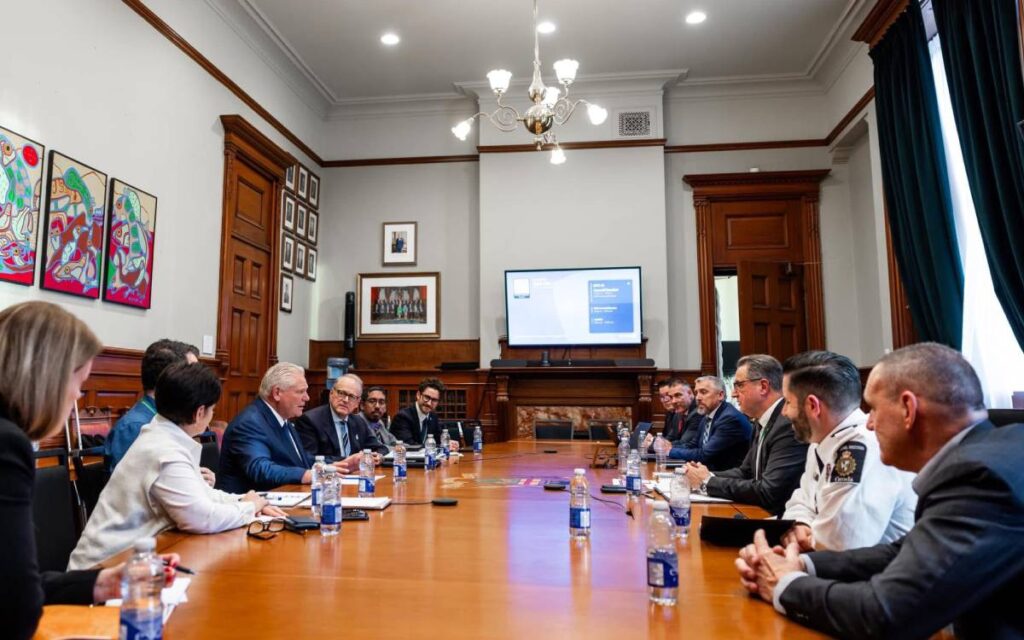
The warning light has been blinking for months, but action wasn’t taken. Pictured: Ontario Premier Doug Ford chairing emergency meetings. Photo Credit: Doug Ford/X.
Talk of Team Canada kicked into high gear this week. After President-elect Donald Trump announced Monday night that an executive order imposing a 25 per cent tariff on all products coming into the United States from Canada and Mexico will be issued on Jan. 20, a flurry of activity was unleashed by the federal government and provincial counterparts.
For context, Trump was elected on a promise to implement a minimum 10 per cent global tariff on all imported products. Trump is sparing no time delivering on his mandate for the American people and it’s no coincidence that he is cracking down on the two countries bound to the U.S. by a shared border, as well as a trade agreement that is up for renegotiation in 2026.
His posturing is strategic. Trump’s voter coalition expect action on crime and immigration, and that’s exactly what the president-elect is looking to deliver. As part of his anticipated retaliatory action against Canada and Mexico, he is seeking a crackdown on the flow of people and drugs into the United States.
Since the news broke on Monday about these punitive tariffs, a first ministers meeting’ was called after Ontario Premier Doug Ford issued a call to action to Prime Minister Justin Trudeau to gather everyone around the table. The goal? Come up with a unified Team Canada approach to counter the heavy hand of the incoming U.S. administration.
Sure, having everyone sing from the same songbook is the ideal approach. It saves from needless distractions that can come from a patchwork strategy of differing opinions about how to solve the problem. But the problem for the Trudeau government is that the strategy may be too little, too late.
Two things can be true at the same time. The first priority should be to stand up and defend the interests of Canadian companies and their employees during a period of political instability.
But there are also actions that could have been taken before now. Public Safety Minister Dominic LeBlanc said this week that the federal government is considering options to supply more resources at the border.
Why didn’t this happen sooner? Earlier this year, Trudeau appointed several cabinet ministers to lead the charge on safeguarding Canada’s economy in the face of a change election. The committee could have focused their efforts on identifying areas of vulnerability that could be put on blast and weaponized, as is the case now.
While Trump is currently hung up on dealing with crime and immigration, it’s only a matter of time before the other shoe drops on defence spending. Canada lags behind many of its NATO allies in terms of meeting the two percent threshold, and it is increasingly a topic of conversation amongst Republican lawmakers.
Based on Monday’s declaration of massive tariffs on Canadian goods entering the U.S., it’s clear that Trump plans to fight his battles on social media, rather than resolve things behind closed doors. The president-elect is looking for an early and decisive win, putting Canada on the back foot once again.
The Team Canada spirit is all well and good. Uniting behind a common cause is important. But at the end of the day the warning light has been blinking for months, and action wasn’t taken. If previous experience is indicative of things to come, Canada is in for one rough ride.

Josie Sabatino is a Senior Consultant at Summa Strategies, focused on providing strategic insight and helping clients meet their objectives in an ever changing and complex political and regulatory environment. Prior to joining Summa, Josie spent nearly a decade in political communications and most recently served as the Director of Communications to the Hon. Erin O’Toole, former Leader of the Official Opposition.






